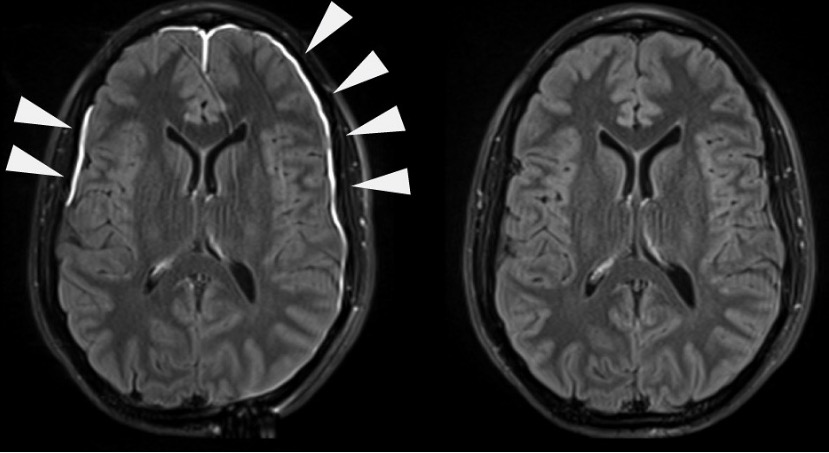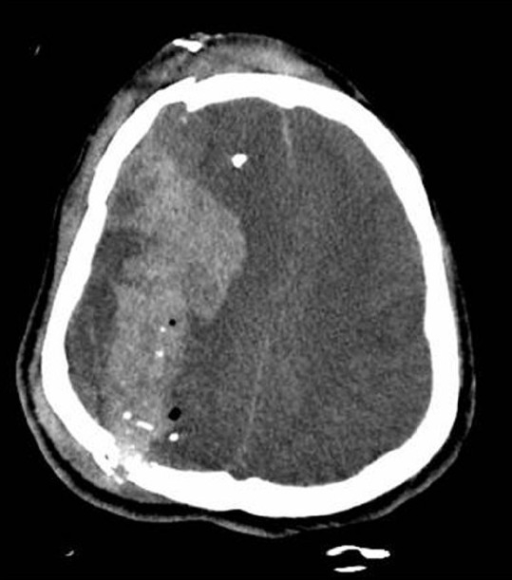Playlist
Show Playlist
Hide Playlist
Acute Bacterial Meningitis: Predisposing Factor Head Trauma
-
Slides 10 CNSInfections Neuropathology I.pdf
-
Download Lecture Overview
00:01 Here's another table with acute bacterial meningitis, but this time we're dealing with trauma. 00:06 In the previous table, we looked at common causes of acute meningitis, primarily bacterial. 00:13 And the parameter that we use there was age groups. 00:16 And we begin with very young and very old, two extremes and then you had everything in the middle. 00:23 Remember, the age between, let's say, two and 50 years of age, you're looking at organisms such as neisseria meningitis, and maybe streptococcus pneumonia. 00:32 Now, in this table, what we're paying attention to is, well, what if there was a external type of damage taking place to the skull? So, as opposed to age groups, let's say that there was a basilar skull fracture, and what kind of common bacterial pathogens could be seen? Now, once again, one of the exceptions is going to be haemophilus influenza for convenience sake, I have group everything together here, please forgive me. 00:59 Now, here, vancomycin, and plus your third generation cephalosporin, is what you're thinking. 01:04 If there was a penetrating trauma, what kind of organisms are going to make it into the brain or into the cavity? Well, here, it could be staph aureus, or coagulase-negative, such as your staphylococcus epidermidis. 01:23 You could have aerobic gram-negative bacilli, including pseudomonas. 01:26 And here we have, once again, common denominator would be your vancomycin. 01:31 And we have different types of our cefepime, our ceftazidime and so on and so forth. 01:39 Common denominator, vancomycin. 01:42 Their overall, what we're looking at here is meningitis. 01:46 We did age groups, and trauma and common organisms that would then be expected to be seen. 01:52 Predisposing factor continuing on this table here is if the patient was post-neurosurgery. 02:01 And here, you should be thinking about aerobic gram-negative bacilli. 02:04 And here, once again, it would be something like your pseudomonas, and we have coagulase negative, such as our epidermidis. 02:14 Post-surgery, what happened, patient unfortunately, starts developing symptoms of meningitis, Vancomycin, common denominator. What if there was a shunt? So what if a shunt was required? Remember, whenever there is a shunt that is required in your patient, there's every possibility that you have organisms that has gained access. 02:35 So, here, once again, we have your coagulase negative, staphylococcus epidermidis, and others including our pseudomonas. 02:44 The other one that you find to be quite interesting as well with the CSF shunt is think about, look at these organisms. Why these organisms are coming from? Looks like your flora of the skin, including your propionibacterium acnes. 03:00 Isn't that interesting? And vancomycin. 03:02 So overall, understand the concept and once you do, then you plug in the details as to what are the organisms that are gaining access to the cranial cavity? In summary, risk factors, well, walk through a bunch of them. 03:21 Age groups, obviously, we have trauma, post-neurosurgery or maybe CSF shunts, preventive medicine, signs and symptoms as you can expect from meningitis, nuchal rigidity, headache, photophobia. 03:35 Differential diagnosis, just to keep this in mind, sinusitis, or abscess, but the presentation will be quite different. 03:41 Diagnostic workup, head CT, and blood cultures and of course lumbar puncture. 03:47 We spent extensive time on the table with lumbar puncture. 03:50 Treatment, obviously, antibiotics of various sorts.
About the Lecture
The lecture Acute Bacterial Meningitis: Predisposing Factor Head Trauma by Carlo Raj, MD is from the course CNS Infections - Clinical Neurology. It contains the following chapters:
- Acute Bacterial Meningitis: Factor - Head trauma
- Bacterial Meningitis: Summary
Included Quiz Questions
Which of the following conditions that predispose to purulent meningitis can be managed with vancomycin and ceftriaxone?
- Injury from basilar skull fracture
- Injury from penetrating head trauma
- Post neurosurgery
- Injury from placing a CSF shunt
A 55-year-old man with a history of hydrocephalus presents to your clinic for a follow-up. He has a shunt placed to drain his CSF. Which of the following is the most likely pathogen that causes meningitis in this patient?
- Staphylococcus epidermidis
- Listeria monocytogenes
- Streptococcus pyogenes
- Streptococcus pneumonia
- Neisseria meningitidis
Which of the following is the recommended drug regimen for the empirical management of meningitis in a patient after a neurosurgical procedure?
- Vancomycin plus cefepime
- Ciprofloxacin
- Vancomycin plus ciprofloxacin
- Ceftriaxone and cefepime
- Meropenem and ceftriaxone
Customer reviews
3,8 of 5 stars
| 5 Stars |
|
2 |
| 4 Stars |
|
1 |
| 3 Stars |
|
0 |
| 2 Stars |
|
0 |
| 1 Star |
|
1 |
everything is explained really well. everyone makes mistakes and so despite the one mistake it is really informative and consice. Dr Raj's videos are really good
No matter what, I appreciate Dr. Raj, I have been watching his videos and I have watched more than a bunch of his videos. I want to say a big thank to you and the whole Lecturio team :) thank you for such a wonderful system and teacher who is making learning Medicine easier and clearer. Thanks a bunch
Despite that Dr. Raj inaccurately recognized H. influenzae as a virus (which is actually a G(-) bacterium), he did a good job of engaging students in thinking and reflecting, while pointing out a general memory-aiding scheme ( e.g. common skin flora species being implicated in post-neurosurgery/penetrating trauma/CSF-associated meningitides) Having watched many of Dr Raj's videos (a med-student with high standards myself and always hateful of lackadaisical teaching styles of the MAJORITY of professors in my country), I have to say Dr. Raj exhibits excellent "mentor" qualities in a style of his own.
A very bad lecture. Mistakes that can not be said lecture after lecture





